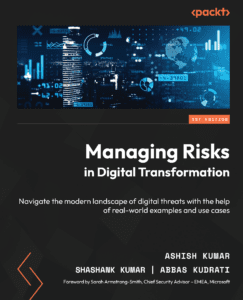Shashank Kumar is the author of Managing Risks in Digital Transformation, we got the chance to sit down with him and find out more about his experience of writing with Packt.
Q: How did you become an author for Packt? Tell us about your journey. What was your motivation for writing this book?
Shashank: Ashish and I work together in the cybersecurity product division of Microsoft. We were working with some of the world’s topmost customers as COVID hit the world. Through the next few months we saw the landscape of cybersecurity transform at an unprecedented pace.
We also realized that the consequences of the shift led by COVID were very unknown to some of the topmost companies in the the world and then, the idea of writing something which can help anyone and everyone envisage some of the emergent risks took shape.
As we sat down writing from experience and insights, Abbas too joined us and brought his own unique perspectives. Once we had the baseline of the book ready, we approached Packt who very professionally guided us through the pitch process and onwards.
Q: What is the name of your book?
Shashank: Managing Risks in Digital Transformation.
Q: What kind of research did you do, and how long did you spend researching before beginning the book?
Shashank: We researched first with our topmost customers, C-suite leaders and then with some of the developers and other product practitioners around the world. We also leaned into our notes and secondary research from the analysts.
Q: Do you have a blog that readers can follow?
Shashank: I have a substack – “Securing Data”. Interested people can check or subscribe to it from shashankk.substack.com.
Q: What key takeaways do you want readers to come away with from the book?
Shashank: 1. Some of the most recent digital transformation trends have made an irreversible impact on the data and digital security landscape. They need to be aware of those changes.
2. There are known and unknown risks from both inside and outside the organization. They should have a framework to estimate the after reading this book.
3. Regulatory landscape will always react to the technological shifts and by reading this book, they can form clear strategies of how to organize their posture.
Q: Can you share any blogs, websites and forums to help readers gain a holistic view of the tech they are learning?
Shashank: I follow a few experts like Graham Cluley who runs a website https://grahamcluley.com/ and Lily Hay Newman (Twitter @Lilyhnewman) to keep myself updated with the latest news and trends in cybersecurity.
Q. Did you face any challenges during the writing process? How did you overcome them?
Shashank: Being active fully employed professionals, time management was perhaps the biggest challenge. I was lucky to have a supportive family that helped me steal hours at end during weekends.
Q. How would you describe your author journey with Packt? Would you recommend Packt to aspiring authors?
Shashank: Packt team was extremely competent, professional and supportive through out journey. I can’t recommend Packt enough to emerging writers.
Q. Why should readers choose this book over others already on the market? How would you differentiate your book from its competition?
Shashank: One of the observations I have from my limited scanning (and I might have missed something) is that it is a unique book in the way we have gone about laying the holistic digital risk landscape. We cover very recent phenomena and also some unique futurist takes. Does not matter if you are a layperson interested in cybersecurity or a business leader looking to secure your commercial interests – this book should add to your knowledge and enrich you with some insights.
Q. What is/are your specialist tech area(s)?
Shashank: My specialist tech areas are Cybersecurity, Data Protection and Insider Risk.
Q. What advice would you give to readers jumping into this technology? Do you have any top tips?
Shashank: The landscape keeps changing and shifting when it comes to data security and regulatory risks. The most important tip in my view is to keep learning and always be on the lookout for the emergent trends. The cycles of innovation in this field are getting shorter and it is important to make “upskilling” a permanent part of your routine.
Q. Do you belong to any tech community groups?
Shashank: Yes, techcommunity.microsoft.com.
Q. What’s your take on the technologies discussed in the book? Where do you see these technologies heading in the future?
Shashank: We have broadly discussed three technological trends – First, Remote work or work from wherever – this trend is going to continue and the hybrid workplace is a reality that will only get further augmented by AI led innovations. Second trend we have talked about is the risk from known and unknown vectors. Generative AI already has brought a lot of unknowns into the play and we see this get further complex for regulatory and risk management frameworks. But as we specify in the book, there are ways in which professionals and organization’s can be proactive about these trends and hopefully our book will help them draw an action plan.
Q. How did you organize, plan, and prioritize your work and write the book?
Shashank: All of us co-authors sat down to first align on the vision for the book. We then distilled that in form of chapters and assigned individual responsibilities. After that, it was us doing our own sections and meeting regularly to discuss the holistic progress. We used each other as sounding boards and mutual reviewers and that helped. On a personal level, it was primarily the weekends and late nights where time had to be taken out. It was taxing at times, but totally worth it overall.
Q. What are your favorite tech journals? How do you keep yourself up to date on tech?
Shashank: IEEE Security and Privacy publications are good way to stay up to date with emerging trends. My regular work on emerging security technology with Microsoft and the time I spend with developers and research colleagues is also a great source of insights. Springers journal of cryptology is a good publication to follow as well.
Q. Would you like to share your social handles? If so, mention them below.
Shashank: Of course. @shshank (Twitter), /shashank1kumar (LinkedIn)
Q: What is that one writing tip that you found most crucial and would like to share with aspiring authors?
Shashank: I would time to time imagine myself as the beginner of the field and see if what I wrote made sense to such a person. The ability to empathize with the average reader is something I tried to practice and would advise others to do the same.
You can find Shashank’s book on Amazon by following this link: Please click here









